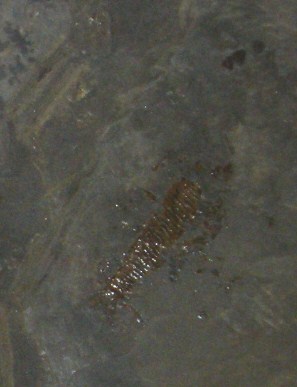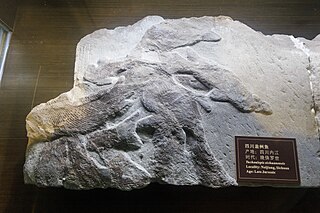
Osteolepis is an extinct genus of lobe-finned fish from the Devonian period. It lived in the Lake Orcadie of northern Scotland.

Thrissops is an extinct genus of stem-teleost fish from the Jurassic and Cretaceous periods. Its fossils are known from the Solnhofen Limestone, as well as the Kimmeridge Clay.

Strunius is an extinct genus of lobe-finned fish from the Late Devonian period of Germany and Latvia.

Sea Monsters: A Prehistoric Adventure is a 2007 American IMAX 3D documentary film by National Geographic, about prehistoric marine reptiles. It alternates modern-day sequences about the work of scientists studying the animals with computer-animated scenes depicting the prehistoric past.
Coriops is a genus of prehistoric bony fish. Its fossils are found in Campanian, Maastrichtian, and possibly Paleocene age deposits. This chronological distribution means that the genus may have survived the Cretaceous–Paleogene extinction event that killed the dinosaurs.

Hupehsuchus is an extinct genus of small marine reptiles, about 1 m (3 ft) long, found in the area of Hubei in China. This marine reptile lived in the Olenekian stage of the Early Triassic period. It was probably a filter feeder, like modern baleen whales.
Flindersichthys is an extinct genus of prehistoric bony fish that lived during the Albian stage of the Early Cretaceous epoch.
Oligopleurus is an extinct genus of prehistoric bony fish that lived during the Kimmeridgian stage of the Late Jurassic epoch.
Paralogoniscus is an extinct genus of prehistoric bony fish that lived during the Cisuralian epoch in what is now East Kazakhstan, Kazakhstan. It could reach body lengths of up to ca. 50 cm (20 in).

Habroichthys is an extinct genus of prehistoric bony fish that lived during the early Ladinian stage of the Middle Triassic epoch, 242 to 232 million years ago. It has been found in Austria, China, Italy, Slovenia, and Switzerland. It was a small fish measuring 26 cm (10 in) long.
Cycloptychius is an extinct genus of prehistoric bony fish that existed in the Late Devonian epoch and the Carboniferous period in what is now France, Russia and the United Kingdom.
Ceramurus is an extinct genus of prehistoric bony fish.

Dipteronotus is an extinct genus of stem-neopterygian ray-finned fish that existed during the Middle and Late Triassic epochs in what is now Europe and Morocco. As a typical feature, it had several ridge scales in front of its dorsal fin that created a spine-like structure.

Yuchoulepis is an extinct genus of prehistoric ray-finned fish.
Uydenia is an extinct genus of prehistoric bony fish from the Cisuralian of Kazakhstan.

Todiltia is an extinct genus of prehistoric bony fish.

Gyrolepis is an extinct genus of prehistoric ray-finned fish from the Middle-Late Triassic epochs in what is now Europe. It is known both from complete specimens and isolated skeletal elements, such as scales or teeth.

Eoeugnathus is an extinct genus of prehistoric ray-finned fish belonging to the Halecomorphi. Eoeugnathus existed during the Middle Triassic in what is now Italy, Spain, and Switzerland. The type species is Eoeugnathus megalepis (monotypy).

Ohmdenia is an extinct genus of prehistoric bony fish that lived from the Toarcian stage of the Early Jurassic period. Ohmdenia was first described in 1953 by Bernhard Hauff, based on a fossil found in the well-known Posidonia Shale in Holzmaden, Germany. For a long time this animal has been considered a close relative of Birgeria, a great predator typical of the Triassic period with an uncertain systematic position. Further studies have shown similarities with the Pachycormiformes, a group considered close to the origin of teleosts and also including giant forms and planktives. Some studies have erroneously indicated Ohmdenia as a synonym of Saurostomus, other studies have instead placed Ohmdenia as an important evolutionary passage between the basal pachicormiforms and the more derived planktivore pachicormiformes.

Dorypterus is a small, extinct genus of prehistoric ray-finned bony fish. It lived during the Wuchiapingian stage of the late Permian epoch in what is now Germany (Kupferschiefer) and England. It is a hypsisomatic bobasatraniiform with a high dorsal fin. Due to anatomical differences with other bobasatraniiforms, such as the presence of pelvic fins and the reduced scale cover, Dorypterus is placed in its own monotypic family, Dorypteridae.











